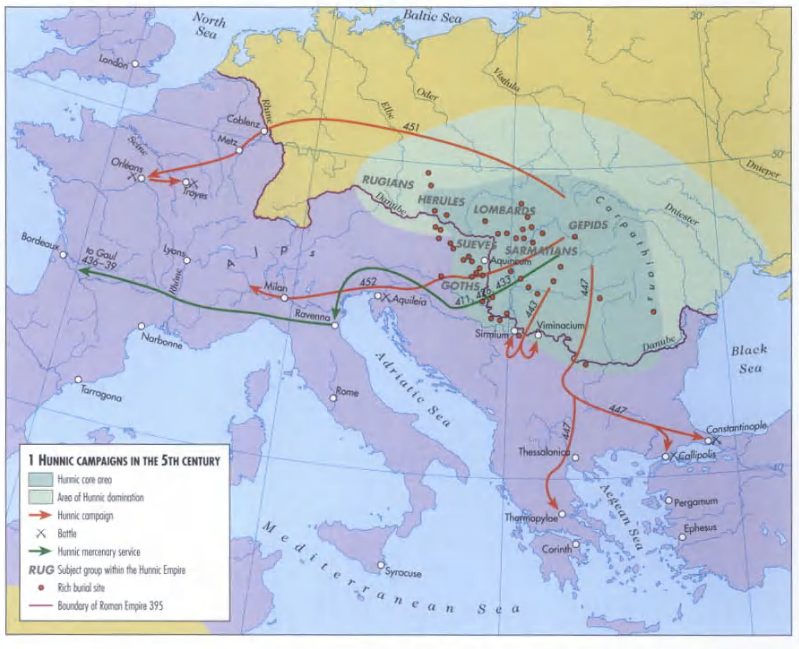Hunnic Campaigns in the 5th Century Map


Marcus Rodriguez
Historical Geography Expert
Marcus Rodriguez specializes in historical cartography and geographic data analysis. With a background in both history and geography, he brings unique...
Geographic Analysis
What This Map Shows
The "Hunnic Campaigns in the 5th Century Map" provides a detailed visualization of the military movements and territorial expansion of the Hunnic Empire during a transformative period in European history. This map highlights key campaigns led by Attila the Hun, showcasing their routes and the regions they impacted from Central Asia to Eastern and Western Europe. It serves as an essential tool for understanding the dynamics of power and conflict during this era, illustrating how the Huns influenced the course of European history through their military prowess.
Deep Dive into Hunnic Campaigns
The Huns, originally a nomadic tribe from Central Asia, emerged as a formidable force in Europe during the late 4th and early 5th centuries. Their rapid mobility and innovative warfare techniques allowed them to conquer vast territories. One of the most significant events was their incursion into the Roman Empire, which reshaped the political landscape of the time.
Interestingly, the Huns were not just brutal warriors; they were also adept at exploiting the weaknesses of their enemies. They often targeted the already weakened provinces of the Roman Empire, which had been suffering from internal strife and economic decline. The Hunnic campaigns were characterized by swift raids, psychological warfare, and strategic alliances with other tribes.
Attila the Hun, perhaps the most famous leader of the Huns, orchestrated some of the most notable campaigns. His invasions of the Eastern Roman Empire (Byzantium) in 441 and Western Roman Empire in 452 were pivotal moments. During these campaigns, the Huns not only demonstrated their military strength but also highlighted the vulnerabilities of the Roman power structure, which was already under pressure from various barbarian groups.
The campaigns resulted in significant territorial gains for the Huns, including parts of modern-day Hungary, Romania, and Austria. These territories became the Hunnic heartland, from which they could launch further expeditions. The Huns' tactics involved both direct assaults and the strategic use of terror, effectively demoralizing their enemies and forcing them into submission.
Moreover, the Huns' influence extended beyond mere conquest; they also impacted trade routes and the movement of people across Europe. Their presence led to the migration of various tribes, including the Goths and Vandals, as they sought refuge from Hunnic aggression. This migration, in turn, contributed to the eventual fall of the Western Roman Empire, illustrating the far-reaching effects of the Hunnic campaigns.
Regional Analysis
Examining the map reveals how the Hunnic campaigns varied by region. In Eastern Europe, for instance, the Huns faced different challenges compared to their incursions into the Western Roman Empire. In regions like the Danube River basin, the Huns encountered established tribes, such as the Gepids and Ostrogoths, which they had to negotiate with or combat.
In contrast, their campaigns in the West, particularly in Italy, showcased their ability to exploit the disarray within Roman territories. Attila's march through Gaul, leading to the infamous Battle of Chalons in 451, exemplified a turning point where the combined forces of the Romans and their allies successfully halted Hunnic advances. This defeat, however, did not diminish the Huns' impact on the region, as they continued to exert influence through fear and political manipulation.
What's fascinating is how these campaigns reshaped the demographics of Europe. The Huns' movements forced many tribes to relocate, leading to a significant reshuffling of power dynamics across the continent. For example, the Visigoths, who initially sought refuge within the Roman Empire, found themselves drawn into conflict as they faced the Huns' relentless pressure.
Significance and Impact
Understanding the Hunnic campaigns is crucial for grasping the broader historical context of Europe in the 5th century. The Huns not only altered borders but also shifted the cultural and political landscape of the continent. Their campaigns highlighted the vulnerabilities of the Roman Empire and acted as a catalyst for the eventual decline of Roman authority in the West.
Today, the legacy of the Huns continues to resonate. The migrations and conflicts triggered by their campaigns contributed to the formation of modern European nations. Moreover, the tactics employed by the Huns have influenced military strategies throughout history, illustrating how one group's approach to warfare can shape the course of human events.
As we reflect on the Hunnic campaigns, it's essential to recognize their role in the larger narrative of European history. The interplay between migration, warfare, and political change during this period laid the groundwork for the development of medieval Europe and beyond. The map serves as a reminder of how interconnected and dynamic our world has always been, even in times of conflict.
Visualization Details
- Published
- October 20, 2025
- Views
- 46
Comments
Loading comments...